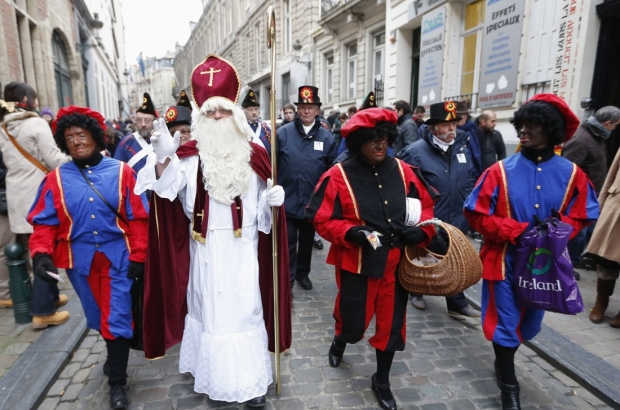- Daily & Weekly newsletters
- Buy & download The Bulletin
- Comment on our articles
Saint Nicolas and Black Pete: 'a Belgian tradition with racist undertones'
Every year in the run up to 6 December, children in Belgium and the Netherlands gear up for the arrival of ‘Sinterklaas’ (in Dutch) or ‘Saint Nicolas’ (in French) , the annual gift-giving celebration, an equivalent to Santa Claus.
Sinterklaas is accompanied by his servant ‘Zwarte Piet’ (Black Pete) or ‘Père fouettard’, typically acted by a white person dressed up in blackface, a curly wig, golden earrings and red lipstick. They play their role as the subservient, unintelligent, childish and clownish caricature helping the old, wise and kind white Saint to carry out the work. They are omnipresent in the weeks preceding 6 December, in bakeries, shopping areas, school celebrations, and shops sell the same caricatural candies and dolls.
While many Belgian and Dutch people see the Black Pete tradition as an ‘innocent’ children’s holiday character, an increasing amount of people consider it offensive and a caricature of Black people.
The Black Pete figure has a direct resemblance to the portrayal of Black people by Europeans dating back to several centuries ago. It perpetuates colonial stereotypical images of Black people.
Blackfacing and stereotyped representations of Black people are the result of a long European history of negation of Africans’ and Black people’s humanity, rooted in the legacy of slavery and colonialism. They reinforce deeply ingrained negative stereotypes of Black people and perpetuate power structures within European societies.
Seeing blackfacing as fun and harmless "dressing up" does not give any consideration to the fact that people of African descent are often confronted with hostility and even violence, simply because of their skin colour. They also face obstacles in accessing employment, housing, education and health; are more likely to be stopped and searched by the police, but also to become a victim of crime; and are under-represented in politics and the media.
Unfortunately the debate on this figure is almost non-existent in Belgium. Concerns about the figure are brushed away as "political correctness gone mad" or seen as an attack on Belgian culture and traditions. The debate is also seen as something that happens only in the Netherlands, but that the Belgian version of Black Pete is "not as bad".
In the Netherlands, although there is still overwhelming public support for Zwarte Piet, there is at least some debate on its racist undertones. The anti-Black Pete movement gained momentum in 2013 after several activists, intellectuals and youth from different cultural and social backgrounds filed a law suit against the city of Amsterdam for granting a permit to the annual Saint Nicolas parade which includes the racist stereotypical figure Black Pete.
In July 2014, the court of Amsterdam ruled that Black Pete, indeed, is a negative stereotype of Black people, although the ruling was later overturned by the highest administrative court in the Netherlands. Both the United Nations and the Council of Europe have also expressed concerns about the racist stereotypes perpetuated by Zwarte Piet, and the continuing racism and racial discrimination faced by Black people and other people of colour in education, the labour market and other areas in the Netherlands.
The message is now finally slowly starting to get through. Four Dutch cities, Amsterdam, The Hague, Utrecht and Maastricht, decided to introduce alternative Petes, coloured or with soot rather than blackface (although this is being criticised because it is seen as a merely artificial change), and many schools and stores have dropped the stereotyped features of his appearance.
The polarisation over this debate highlights the fact Belgian and Dutch institutions continue to struggle with the legacy of their colonial past by maintaining the controversial tradition and disregarding the hurt caused to thousands of citizens and residents of African descent. Offensive traditions can and should evolve to ensure that the Sinterklaas/Saint Nicolas celebration becomes more inclusive.
Georgina Siklossy is the communication officer at the European Network Against Racism, based in Brussels
Photo courtesy De Standaard










Comments
Black Pete is black because he is a demon and in the Middle Ages devils were represented as being black. This way precedes any colonial contact between Europeans and Africans or even any contact at all. Additionally many individuals portraying Black Pete these days are black and brown young men who are themselves wearing blackface and who don't seem to be insulted or humiliated. This tradition is in no way equivalent to the minstrel shows in the US.
@R.Harris if you believe that about the demon then you are very naive. People should just stop defending the indefensible. How do people not see that it's offensive to have the Zwarte Piet in this very modern society.
It Should just be stopped. As for me I am glad to be spending Christmas away from this nonsense for the first time in years.
I am getting tired of people expressing their cultural imperialism, especially without having much knowledge about the back ground of cultures, other than their own, they are criticizing. Generally from the US and the UK they are eager to lecture other cultures on its wrong doings and oversee the wrongs of their own culture. Know it better behaviour like this, with its Orwellian newspeak of accepted and forbidden language is directly to be linked to the neo imperialist adventures in the middle east which wreaked so much havoc. Improve your own culture Ms Siklossy and refrain from commenting the wrongs of others. I much prefer Sinterklaas over a giggling fool running a sweat shop on the North pole.